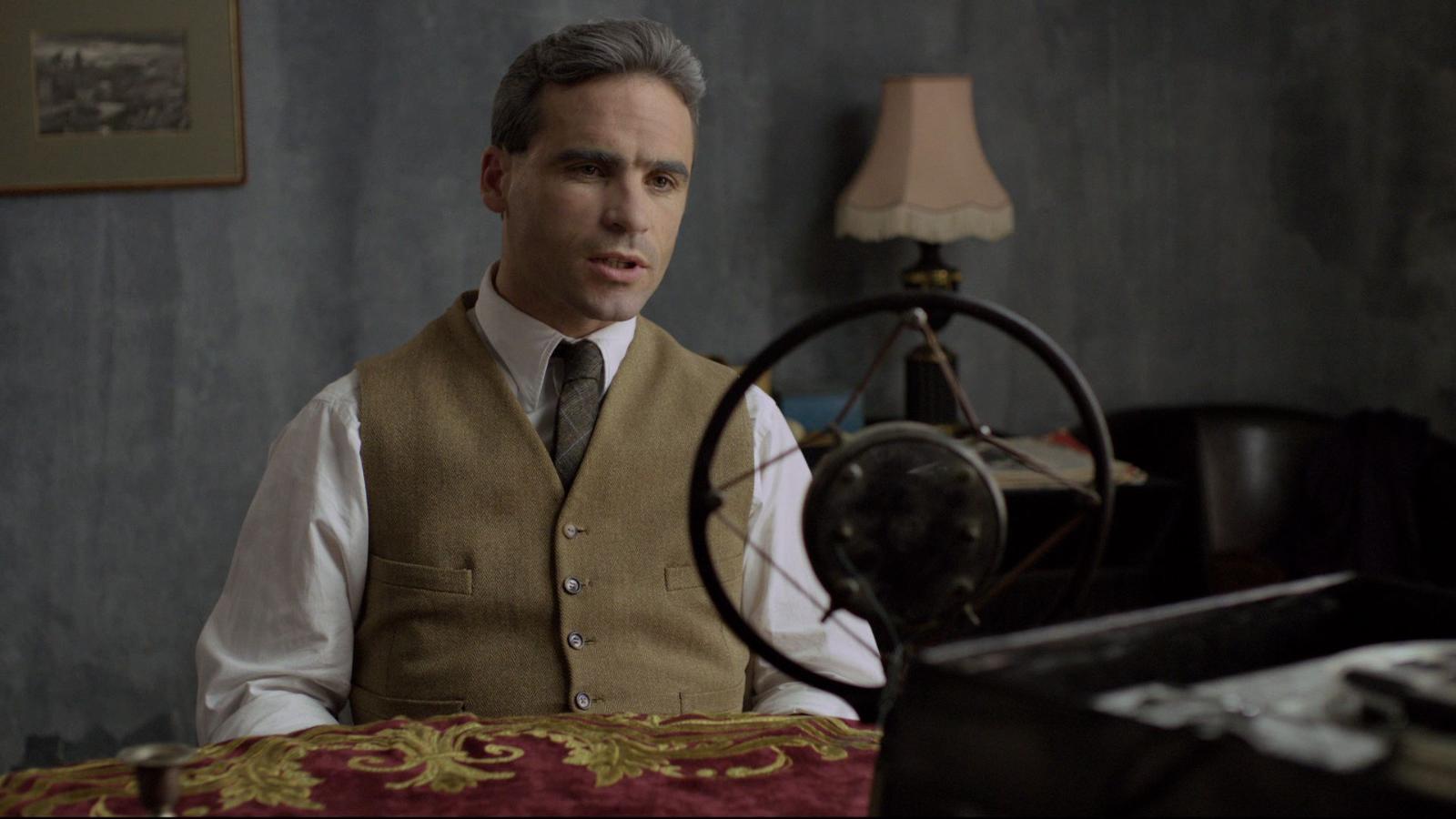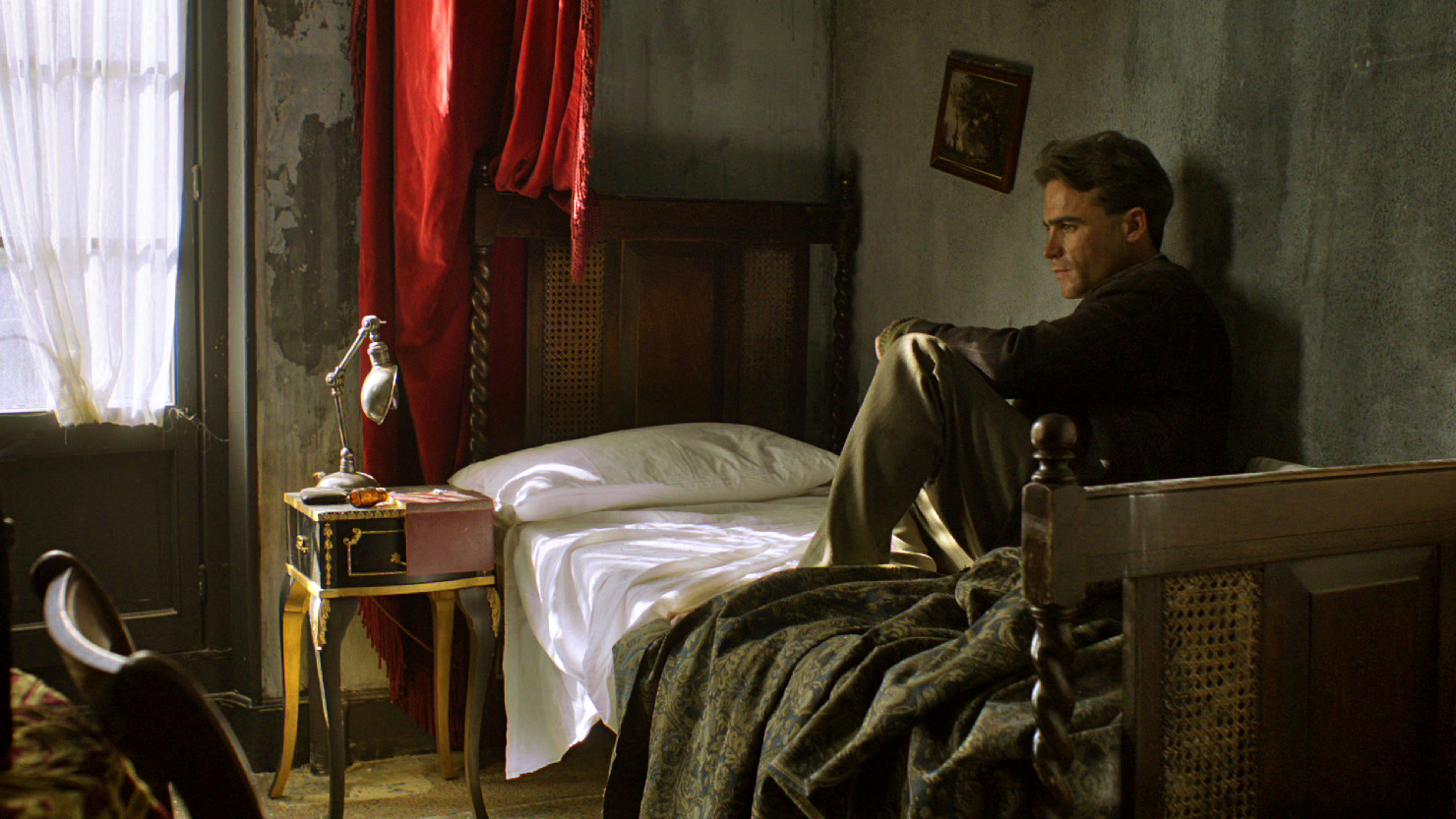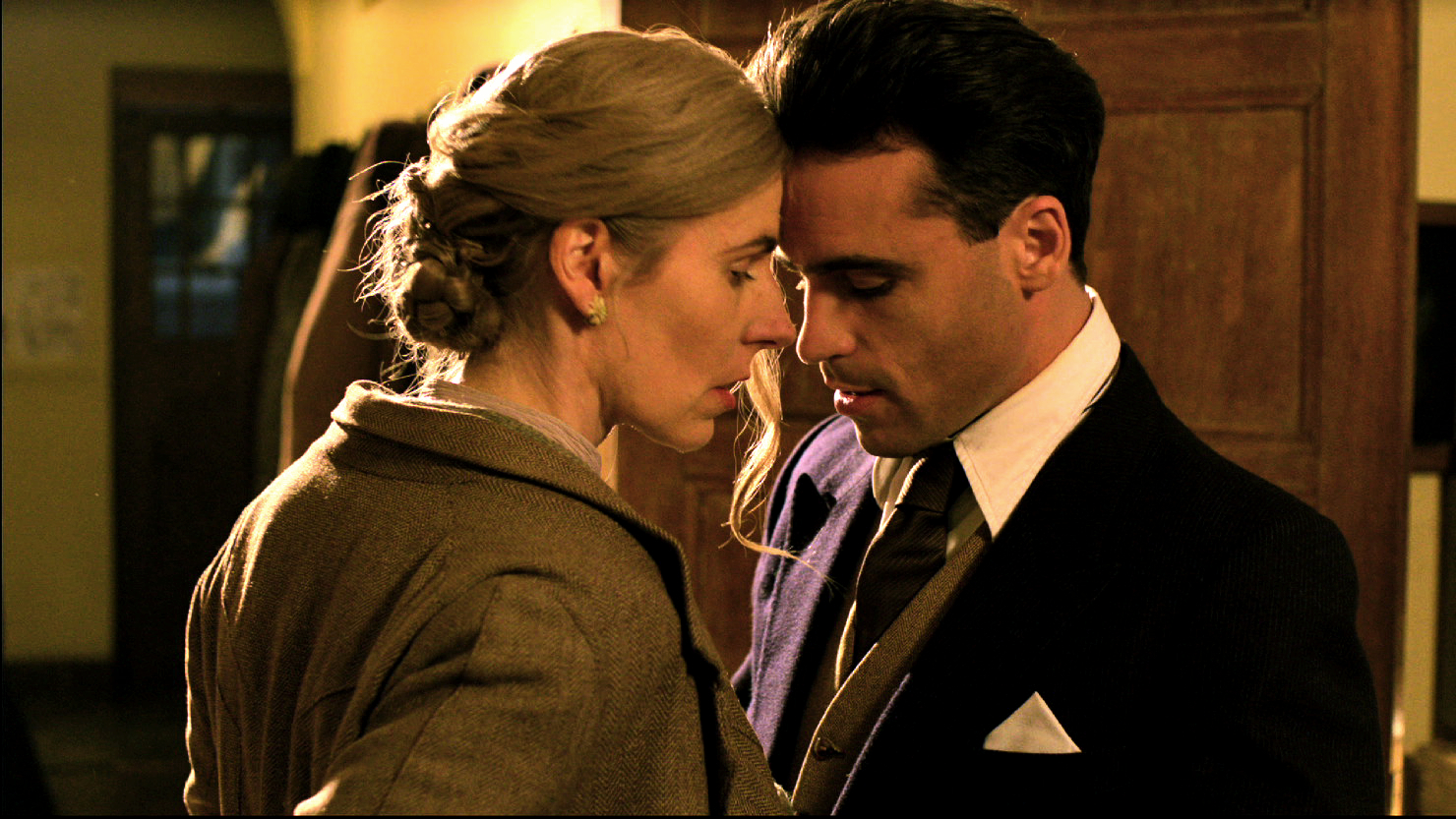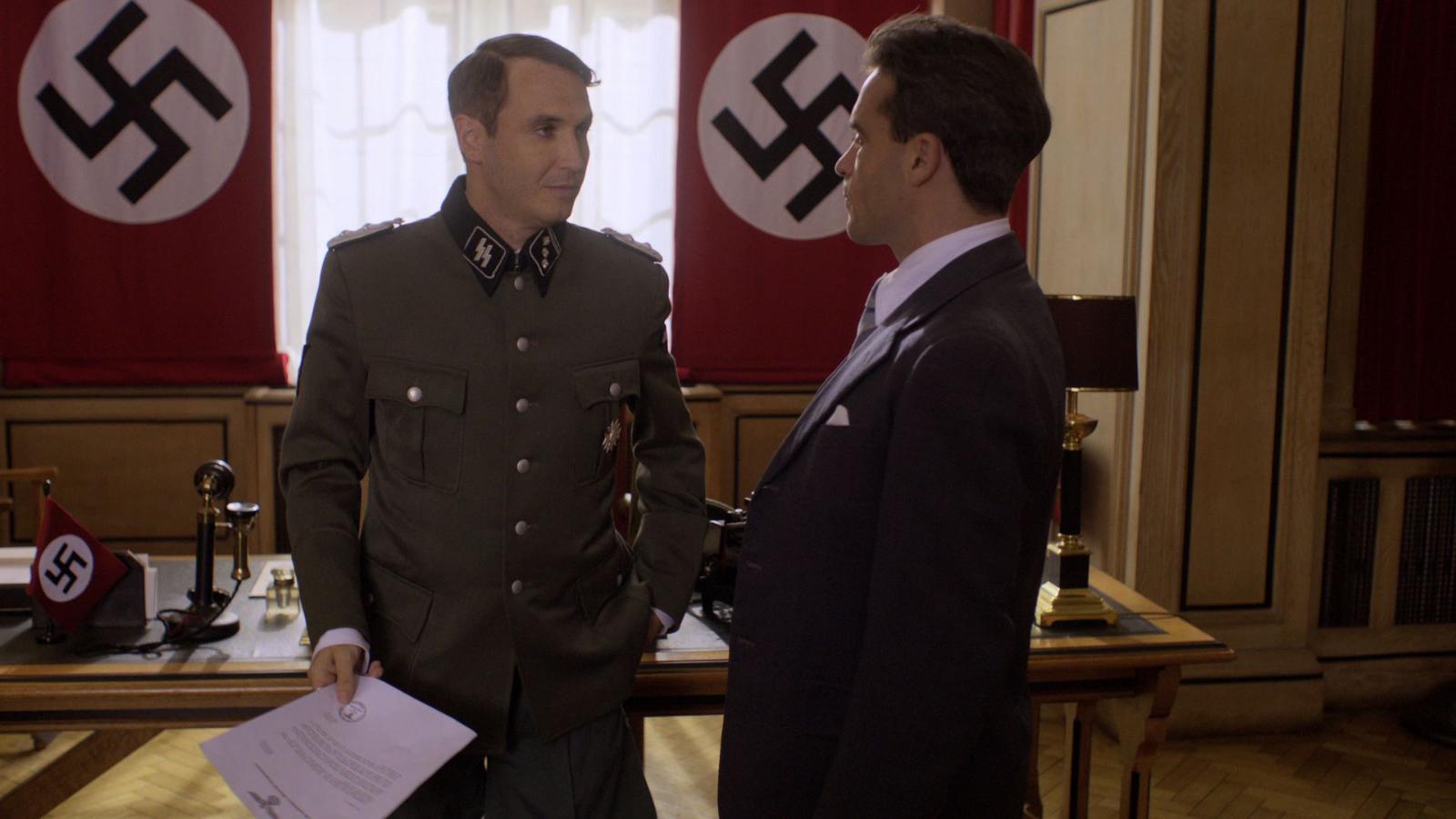Filming Major Ryan
Filmmaker Des Bell and historian Fearghal McGarry outline the challenges and pitfalls involved in their collaboration on a TG4-commissioned documentary film on the life of Frank Ryan.

As is so often the case, the key facts are reasonably well-established but their interpretation remains disputed. Following his capture by pro-Franco Italian forces in Spain in 1938, Ryan was sentenced to life imprisonment in Burgos jail. Unable to secure Ryan’s freedom long after the release of all other International Brigade prisoners and the outbreak of the Second World War, the resourceful Irish minister to Spain, Leopold Kerney, turned to German intelligence (Abwehr II) contacts in Franco’s Spain. Kerney was not alone in doing so: the IRA chief of staff, Seán Russell, recently arrived in Berlin from the United States, had also asked the Germans to secure Ryan’s release, as had Helmut Clissmann, a member of the elite Brandenburg Regiment who had known Ryan in Ireland.
After Ryan’s ‘escape’ was authorised by Franco in July 1940, he was brought by Abwehr to Berlin where he was persuaded to accompany Russell on a secret mission to Ireland. There is no evidence that Ryan had agreed to anything more compromising than accepting an unconventional means of returning home. Russell, in contrast, had put in place an alliance between Nazism and the IRA based on realpolitik rather than ideological compatibility. Following Russell’s sudden death (the result of a perforated ulcer) as their U-boat neared the Irish coast, Ryan – who had no knowledge of the details of Russell’s mission – chose to return to Germany in order to preserve the liaison between republicanism and Germany, a decision he would come to regret. He was apparently motivated by the belief that with a German invasion of Britain (or, many Irish republican believed, a British pre-emptive invasion of Ireland) imminent, his presence in Germany would facilitate an alliance between Irish republicans (including, potentially, the forces of the Irish state) and Germany that might ultimately bring about Irish unification. Such a scenario appeared vastly more plausible in the summer of 1940 than it now does. However, Hitler’s failure to invade Britain, and his assault on the Soviet Union changed everything: it is this context which provides the starting point of Des Bell’s film as a seriously ill and disillusioned Ryan looks back over the events that have brought him to this point.
 The purpose of this article is not to defend the interpretation adopted by our film – viewers will make up their own minds on this (and many still refuse to believe that a leading International Brigader could collaborate with Nazism or that Ryan’s presence in Germany constituted collaboration) – but to identify some of the issues involved in bringing this controversial story to the screen, and to review some of the methods that we have used to communicate this complex historical story to a public audience. The film is part of a wider collaborative project, funded in part by the UK’s Arts and Humanities Research Council, which brings together an academic historian who has written on Frank Ryan and on the Irish in the Spanish Civil War, with a film maker who has produced a series of films for Irish television on historical themes as varied as The Siege of Derry, the Irish diaspora and the role of the Irish in the US labour movement. In addition to facilitating the production of a hopefully historically well informed film on Frank Ryan, the project seeks to address the relationship between academic history and film.
The purpose of this article is not to defend the interpretation adopted by our film – viewers will make up their own minds on this (and many still refuse to believe that a leading International Brigader could collaborate with Nazism or that Ryan’s presence in Germany constituted collaboration) – but to identify some of the issues involved in bringing this controversial story to the screen, and to review some of the methods that we have used to communicate this complex historical story to a public audience. The film is part of a wider collaborative project, funded in part by the UK’s Arts and Humanities Research Council, which brings together an academic historian who has written on Frank Ryan and on the Irish in the Spanish Civil War, with a film maker who has produced a series of films for Irish television on historical themes as varied as The Siege of Derry, the Irish diaspora and the role of the Irish in the US labour movement. In addition to facilitating the production of a hopefully historically well informed film on Frank Ryan, the project seeks to address the relationship between academic history and film.
If writing Irish history is controversial, filming Irish history is generally more so – as was demonstrated by the reception of Neil Jordan’s Michael Collins (1996) and Ken Loach’s The wind that shakes the barley (2006). The strongest criticisms of these works often emanate from academic historians and invariably focus on issues relating to bias and accuracy: historical films are criticised for not representing the complexity of the past and indeed for misrepresenting the historical record. Unease about the way film rides roughshod over matters of historical detail is compounded by a growing awareness of that fact that more and more people receive more of their information about the past from television and cinema than from academic books.
Such criticisms raise legitimate questions about the historical accuracy of filmic accounts of the past, however, it would seem that historians often fail to appreciate the commercial, communicational and formal features of film and television production. In contrast to the academic monograph, which emphasises multiple perspectives carefully evaluated against the available evidence by the historian, film often tells a story from a single perspective and in a subjective and, on occasions, partisan manner. Much of the criticism of The Wind that shakes the Barley, for example, misses the obvious point that the film does not seek to relate the events of the War of Independence in an impartial manner but rather from the point of view of an idealistic left-wing republican. That this is not how most people experienced or subsequently interpreted the conflict does not invalidate the perspective chosen by the filmmaker to tell his or her story: one suspects that concern about the power of the medium to shape popular understanding (the term propoganda is rarely far away) lies behind much of the vehemence of this criticism.
Des Bell in The Enigma of Frank Ryan eschews the traditional broadcast documentary approach employing in favour of a docu-drama’ approach. He rejects a ‘voice of God’ narration and the use of expert witnesses, a form which often can lead to the establishment of a tone in a film whose didactic, authoritative and expository character emulates that of the academic historian. Instead he employs fictive techniques such as the use of renactment involving actors, art design and measured cinematography to reconstruct a sense of the worlds through which Ryan moved. This approach lies somewhere between the historical ‘live action’ movie and traditional documentary. On the other hand, the film encompasses conventional aspects of the latter such as the extensive usage of archival imagery, often intercut seamlessly with live action sequences (for example we see Ryan in a radio studio broadcasting to front line International Brigade troops, then cut to an archive sequence of a propaganda loud-speaker system in the field from Joris Ivens 1937 film, Spanish Earth. This hybrid strategy is clearly signalled at the outset: the film begins by employing the narrative conceit that Ryan has agreed to record his life story for Hans Hartmann, the head of the radio service which broadcast wartime Nazi propaganda to Ireland. This filmic device enables Ryan to relate his own life story in a series of flashbacks directly to the audience without the mediation of an omniscient narrator. The adoption of a vernacular or inflected voiceover that has more in common with the ‘inner monologue’ found in fiction film-making intentionally destabilises the veracity of the narration, while creating a different sort of referential relation of voice to archival image to that found in the traditional television documentary.
 Bell’s script takes liberties that no academic text would or should: characters are conflated (the militaristic Seán Russell is a composite of several IRA figures who Ryan clashed with during the 1930s); dialogue is imagined; encounters are depicted for which there is scant evidence (Ryan, for example, is shown questioning German officials about the concentration camps); the dynamics of personal relationships are altered (greater emotional weight is attached to the relationship between Ryan and his lover Rosamond Jacob than the evidence (Jacob’s fascinating personal diary) permits and Jacob, in turn, becomes a cipher for a feminist critique of Republican masculinist adventurism); and complex ideological debates (such as the conflict between Irish nationalists and internationalists in the International Brigades, or the existence of a shifting spectrum of views between militarism and socialism within the IRA) are condensed into emblematic scenes which given the determinants of screen time, can merely hint at the complexity of the issues involved.
Bell’s script takes liberties that no academic text would or should: characters are conflated (the militaristic Seán Russell is a composite of several IRA figures who Ryan clashed with during the 1930s); dialogue is imagined; encounters are depicted for which there is scant evidence (Ryan, for example, is shown questioning German officials about the concentration camps); the dynamics of personal relationships are altered (greater emotional weight is attached to the relationship between Ryan and his lover Rosamond Jacob than the evidence (Jacob’s fascinating personal diary) permits and Jacob, in turn, becomes a cipher for a feminist critique of Republican masculinist adventurism); and complex ideological debates (such as the conflict between Irish nationalists and internationalists in the International Brigades, or the existence of a shifting spectrum of views between militarism and socialism within the IRA) are condensed into emblematic scenes which given the determinants of screen time, can merely hint at the complexity of the issues involved.
Do such condensations and creative licence make for bad history? For the scholarly historian – whose stock in trade is the careful evaluation of empirical evidence – the fact-based, drama genre represents a challenge. Is it legitimate to create scenes for which there is no evidence, particularly as the viewer cannot be expected to know which events occurred and which have been invented by the director as dramatist? At what point do such acts of dramatic licence fatally compromise the critical value of a film as an engagement with history?
The contribution of some historians to the live debates that have followed screenings of our film (and in other social media forums) seem to largely consist in listing the numerous failings of the film as it departs from the historical record. These identified sins of omission (of context and detail) and of commission (of falsification of the record) reflect a strong awareness by historians of the limitations of film in comparison to the academic text in matters of historical fidelity. However, this perjorative stance also displays a limited appreciation of the strengths of the medium. That this is frequently the default response of historians makes it difficult for audiences to discern between films which engage meaningfully with the substance of history and films which engage more with the genre and history of film itself than the historical subject matter they exploit for inspiration. However ‘the fidelity fetish’ betrays not only a limited appreciation of the cinematographic medium but also of what French philosopher Jacques Ranciere calls the ‘poetics of history’, that is to say the literary and figurative dimensions of the writing of history which is after all a literary endeavour bound by narrative and characterological considerations as well as by ‘scientific’ method. Film may flaunt its poetics more than a discipline of history (while still eliding the materiality of the filmic process), but history also has its tropes, elipses and fictions where subject position and ideological interest may be disguised in claims of value freedom and objectivity.
As James Chandler noted in a recent Field Day Review article, in the mid-1990s the American Historical Review merged its growing number of historical film reviews with its book reviews. However in 2006 the A.H.R. ended this practice for the following reasons:
Our reviewers have usually been historians with little training or expertise in film studies and often with little interest in the medium other than as moviegoers. No wonder the dominant approach of reviewers had been to assess the historical accuracy of a film, paying little attention to the specificity of film as a language or mode of representation (something which those with a deep interest in film are quick to point out). When historians review films, they usually write about what they know about – accuracy, verisimilitude, and pedagogical usefulness. These are not inconsiderable as commentary, but it is a far cry from what we expect from them in a book review.
There will always be room for debate on the extent to which the past can be dramatised to tell a historical story to a popular audience. But, in order to engage meaningfully with the medium, historians should develop a greater awareness of the different ways in which filmmakers transform sources and re-construct historical narrative to achieve expressive and revelatory outcomes. One starting point might be an acceptance that film communicates with its audience in ways very different to how academic history serves its readers. Rather than see film as a second-rate form of history another approach might be to accept that film-makers are also practitioners of history, operating to a different set of rules, material restrictions and communicational imperitatives.
 Film’s superior ability to deploy visual sources can contribute to historical understanding in ways that text does not (for example, in the scene where Ryan meets leading Nazi, Dr Edmund Veesenmayer, in Berlin the potency of Nazi iconography makes an arresting case concerning Ryan’s status as a collaborator that the dialogue seeks to undercut). Film’s dramatic appeal, its story-telling qualities, and its ability to engage on an emotional level can vastly extend the reach and impact of historical knowledge.
Film’s superior ability to deploy visual sources can contribute to historical understanding in ways that text does not (for example, in the scene where Ryan meets leading Nazi, Dr Edmund Veesenmayer, in Berlin the potency of Nazi iconography makes an arresting case concerning Ryan’s status as a collaborator that the dialogue seeks to undercut). Film’s dramatic appeal, its story-telling qualities, and its ability to engage on an emotional level can vastly extend the reach and impact of historical knowledge.
There are under-explored commonalities between the disciplines of filmmaking (particularly in the documentary mode) and historical writing: the desire to communicate a story; the creation of narrative structures to do so; the use of empathy and historical imagination to convey a sense of the past and to tease out the import for the present. Academic historians also grapple with evidential problems and truth claims, with subject position and the power-knowledge relation : historians construct radically divergent narratives of the same events, arrive at incommensurable assessments of the documentary record, yet are often reluctant to engage with the critical implications of this partiality.
The ever-growing importance of film and TV documentary as a source of knowledge about the past suggests the need for greater engagement with film and television history by academic historians. Recent years have seen an increased willingness by historians (particularly younger historians) to engage with history on screen – not merely by functioning as talking-heads to be edited into documentaries to provide authority for a narrative the historian has little ability to influence – but by more meaningful collaborations which may entail critical reflection on their own practices.
Our collaboration has deployed a variety of means by which academic history might be more effectively communicated to a public audience. An important principle is that historians and filmmakers who address controversial subjects should be prepared to engage with the public. Our film seeks to open up a dialogue about Frank Ryan his times and his legacy. To that end, screenings of the film have been accompanied by public debates involving the filmmaker, historians, admirers of Ryan, and even the children of characters portrayed in the film. These debates are hosted on a website which also makes available a large body of archival sources to allow people to interpret the historical evidence for themselves, as well as a body of interpretative resources that make explicit the extent to which aspects of the film are based on evidence.
Although changing some of the detail of the past, we hope that our film does not mislead viewers about the fundamental historical and political issues raised by Ryan’s activities in Germany. Although the film aspires to historical reliability, it is also hopes to illuminate the inner core of Ryan’s character and fate in a way different – rather than inferior to – the academic text. Hopefully we have cast some light on the enigma that was Frank Ryan.
A version of this article appeared in History Ireland, May/June 2012.